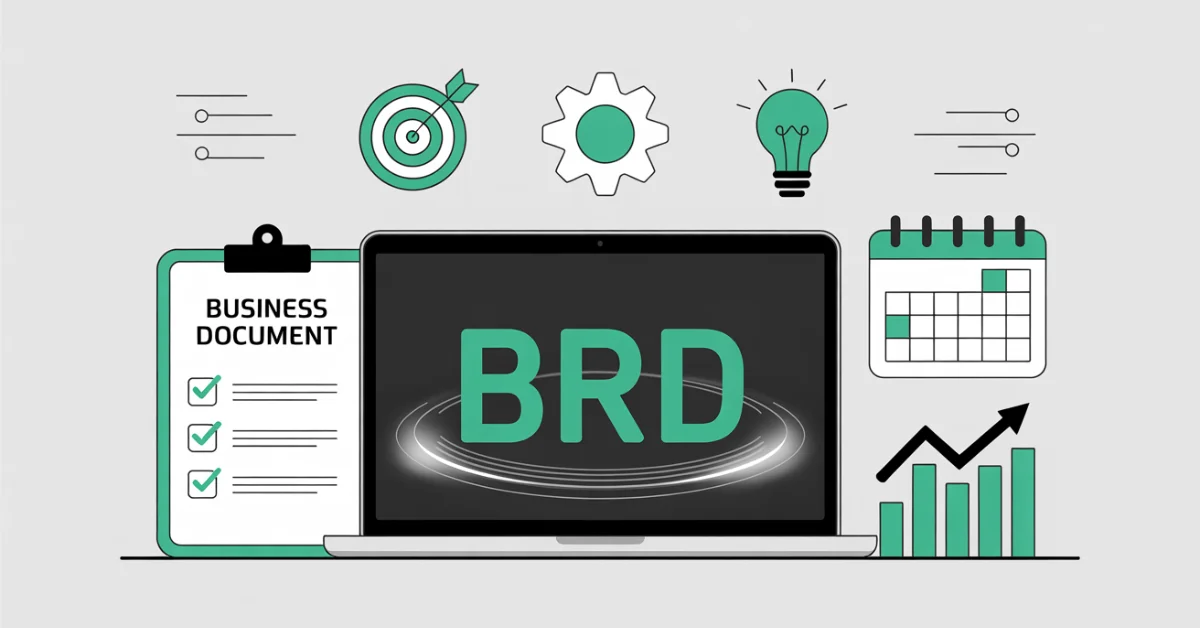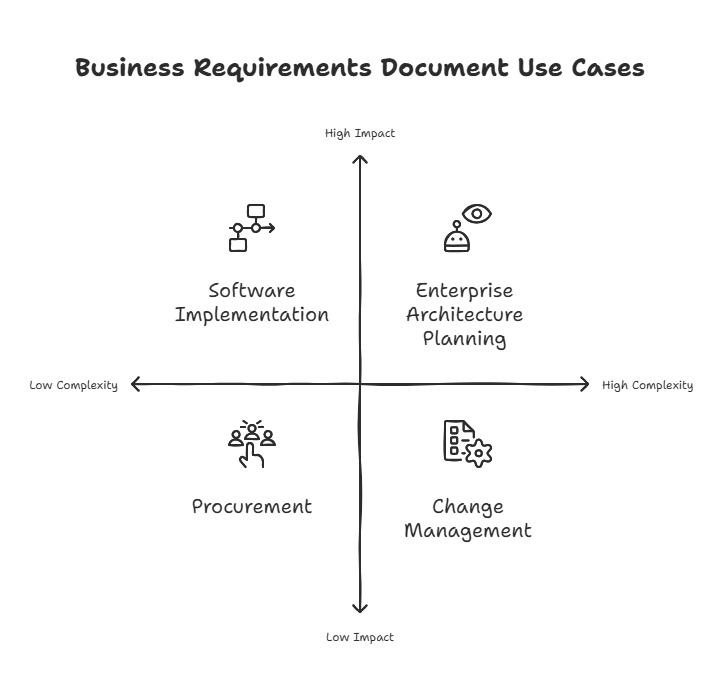
If you ever find yourself asking why you’re working on a project, why you’re building a new product, or why you’re trying to improve a solution, chances are your team hasn’t written a business requirements document.
This document makes the purpose of a project crystal clear and holds the key to unlocking project success by establishing a shared understanding of business needs, minimizing risks, and ensuring the final deliverable aligns perfectly with stakeholder expectations.
Keep reading to learn more about the business requirements document and how to write one for your team.
Table of Contents
What is a Business Requirements Document (BRD)?
A business requirements document (BRD) is a formal document that clearly articulates the business needs, goals, and expectations for a specific project or initiative. This piece of project documentation outlines what the business wants to achieve and why the project is necessary.
The BRD answers questions such as:
- What problem are we trying to solve?
- What are the goals and objectives of this project from a business perspective?
- What are the high-level requirements that the solution must meet?
- Who are the key stakeholders involved?
- What is the desired outcome or benefit for the business?
The BRD is the first in a series of documentation aimed at ensuring project success that also includes the product requirements document (PRD), functional requirements document (FRD), and technical requirements documentd (TRD).
Why is a BRD Important?
BRDs are important for a multitude of reasons, all contributing to a higher likelihood of project success and delivering desired business value. Think of it as laying a solid foundation before building a house—without it, the entire structure is at risk.
Notable BRD benefits include:
- Establishing a consensus on project objectives and desired outcomes.
- Defining what the solution should achieve from a business perspective.
- Setting a clear scope and ensuring the project stays focused on delivering the intended business value.
- Facilitating communication for all project-related discussions and decisions.
- Aiding in risk mitigation throughout the life of the project.
Key Components of a BRD
What is a BRD’s format? It will differ between companies and even projects within the same company, but here are several common sections.

Executive Summary
The opening section of every BRD should provide a high-level overview of the project and the business need it addresses, setting the stage for the entire document.
Project Objectives
This section clearly states the objectives and goals of the project, articulating why this initiative is being undertaken.
Project Scope
This defines the boundaries of the project, explicitly outlining what will and will not be included to manage expectations and prevent scope creep.
Business Requirements
These are the specific needs and capabilities the solution must deliver from a business perspective, forming the core of the document.
Key Stakeholders
This identifies the individuals or groups who have an interest in or will be affected by the project, ensuring all perspectives are considered.
Assumptions
This section lists any factors believed to be true during the project planning, acknowledging potential dependencies and uncertainties.
Constraints
These are the limitations or restrictions that may impact the project, such as budget, timeline, or technology limitations.
Cost-Benefit Analysis
This section systematically compares the anticipated costs of the project against the expected benefits, providing financial justification for the initiative.
When to Use a BRD (with Use Cases)
There are many contexts in which a BRD adds value. Here’s when to write a BRD:

- Procurement. When acquiring a new system or service, a BRD clearly outlines the business needs and required functionalities to ensure the selected solution meets organizational demands.
- Change management. For significant organizational changes involving new processes or systems, a BRD defines the business rationale, desired outcomes, and necessary adjustments.
- Software implementation. Implementing new software necessitates a BRD to detail the required features, integrations, and business process alignment for successful deployment.
- Enterprise architecture. When planning future technology landscapes, a BRD can articulate the business capabilities and requirements that the architecture needs to support.
Business Requirements vs. Functional Requirements
Business and functional requirements are often confused because they are closely related and build upon each other in the project lifecycle.
Business requirements describe the high-level needs of the organization and the goals the project aims to achieve from a business perspective. They focus on the why and what in business terms.
Functional requirements detail how the system or solution will meet the business needs—the specific actions, behaviors, and functionalities the system will employ to fulfill identified business requirements. They focus on the what in technical terms.
How to Write a BRD: Step-by-Step
Want to create a BRD for your next project? Follow these concise BRD writing steps:
- Identify needs. Begin by clearly defining the business problem or opportunity and the initial high-level goals for the project through discussions with key stakeholders.
- Gather and document requirements. Conduct thorough requirements gathering sessions (e.g., interviews, workshops, surveys) with stakeholders to uncover detailed business needs and expectations, then document your findings.
- Develop functional and non-functional requirements. Translate the business requirements into specific functional (what the system will do) and non-functional (how well it will do it) requirements.
- Obtain stakeholder approval. Circulate the completed BRD for review and formal approval by all key stakeholders to ensure alignment and agreement.
- Manage revisions and updates. Establish a process for managing feedback and incorporating necessary revisions to the BRD throughout the project lifecycle.
Once complete, you should use the approved BRD as the guiding document for all subsequent project activities, ensuring continuous alignment with agreed upon business needs.
Best Practices for Writing a BRD
For maximum impact, consider these BRD best practices:
- Be clear and concise. Use straightforward language, avoiding jargon and ambiguity to ensure everyone interprets the requirements correctly.
- Maintain traceability. Ensure a clear link between business requirements, functional requirements, and ultimately, the delivered solution.
- Prioritize requirements. Clearly indicate the importance of each requirement (e.g., must have, should have, nice to have) to guide development efforts.
How BRDs Fit into the RFx (Procurement) Process
The BRD often precedes and informs the request-for-x (RFI, RFP, RFQ) process. It defines the business requirements that the RFx aims to address. This ensures that the solicitation accurately reflects the organization’s needs, enabling vendors to provide relevant and comparable proposals, ultimately leading to a better selection.
BRD FAQs
Need some last-minute clarity on this topic? Here are a few FAQs about BRDs.
What is a Good Example of a Business Requirement?
Here’s an example that’s focused on customer relationship management (CRM):
The new CRM system must enable sales representatives to easily track all interactions with potential clients to improve lead conversion rates.
It’s a good example because it:
– Clearly states a business need.
– Identified a specific user group.
– Indicates a desired outcome.
– Implies a priority.
Who Prepares a BRD?
The responsibility for preparing a BRD typically falls on a business analyst or technical writer. These roles work closely with various stakeholders to understand their needs, analyze the business problem, and document relevant findings in the BRD.
What is the Difference Between a BRD and FRD?
The BRD focuses on the needs and goals of the project from a business perspective. It describes what the business wants to do and why.
The FRD details how the system or solution will meet the business needs. It describes what the system will do in technical terms.
Ensure Your BRD is Purposeful and Clear with EDC
Whether you need a single technical writer for a brief BRD project or a team of consultants to produce a complete line of documents, EDC’s consultants have the knowledge and expertise needed to deliver the highest quality documentation.
Plus, our clients work closely with an engagement manager from one of our 30 local offices for the entire length of your project at no additional cost.
Contact us at (800) 221-0093 or [email protected] to get started.
Read more about: How to Write a Technical Requirements Document
